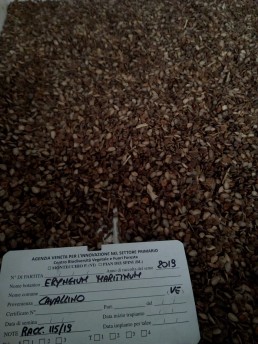A NURSERY FOR THE DUNE FLORA
The LIFE REDUNE project envisages the reconnection and restoration of 92,000 square metres of mobile dunes and the requalification and/or expansion of 823,000 square metres of transitional and fixed dune habitats, variously altered by disturbances caused by human action.
The restoration of the valuable coastal habitats can be achieved on the one hand by acting on the containment of the impact due to tourism and erosion and on the other hand by recreating the dune habitats through the implantation of native plants that accelerate the reconstruction of the vegetation cover.
LIFE REDUNE is "reconstituting" the dune habitats, with 151,000 native plants, germinated and grown in greenhouses, divided as follows:
- habitats of the mobile dunes 2110 and 2120 (Ammophila arenaria, Elymus farctus, Echinophora spinosa,Medicago marina, Eryngium maritimum, Euphorbia paralias, Calystegia soldanella and others): 35,000
- habitat 2130* (Teucrium polium, Fumana procumbens, Sanguisorba minor, Lomelosia argentea, Centaurea tommasinii, Globularia bisnagarica, Koeleria macrantha, Heliantemum nummularium ssp. obscurum and others): 45,000
- habitat 2250* (Juniperus communis, Crataegus monogyna Berberis vulgaris, Viburnum lantana, Phillyrea angustifolia and others): 55,000
- Habitat 2270* (Phllyrea angustifolia, Asparagus acutifolius, Rubia peregrina, Smilax aspera and others): 15,000
- Stipa veneta*: 1,000
.
.
.
.
.
Native seedlings speed up the reconstruction of the plant cover where it has been damaged, at the same time subtracting land from harmful invasive alien species. According to studies conducted by the Cà Foscari University, for example, the invasive alien species Oenothera stuchii seems to be adversely affected by a high level of soil coverage by native species, while on the other hand it proliferates in areas most degraded by trampling and erosion which, by stripping the soil of its natural turf, makes it subject to invasion by this and other undesirable plants.
Stipa veneta is a priority species at high risk of extinction, of which fewer than 300 mature individuals remain in the wild.
Some of the most prickly plants in habitats 2250* and 2270* are used for the creation of living interdiction systems, in synergy with walkways, fences and information signs, to promote the use of only the permitted passages to reach the beach.
Ahead of the reconstruction work, therefore, there is a demanding nursery project conducted by Veneto Agricoltura's Plant Biodiversity Centre in Montecchio Precalcino (Vicenza). A regional structure specialising in the multiplication of native plants, the Centre actually transforms seeds collected in the wild into seedlings that can be used in the restoration work in the area.
A sequence of actions that begins with the search, in the wild, for populations of wild plants suitable for providing seed in sufficient quantity and quality to guarantee the "production" of the number of seedlings required by the project. This first, fundamental phase involves inspecting the area and requires botanical skills, a trained eye and experience. Once the most suitable wild stands have been identified, usually those with a high number of individuals, the seed is collected, taking great care to organise the collection days at the right time. If the seed is not yet ripe, in fact, harvesting has to be postponed and we have therefore made an "empty" trip: a waste of time and the unnecessary travelling of hundreds of kilometres. If, on the contrary, you arrive too late, the seed has already fallen and is no longer available. Nature seldom allows for a repeat performance, and arriving even a week late can sometimes force the production of seedlings to be postponed for a very long time.
For many of these species, it can take almost a year and a half from the day the seed is collected until the seedling obtained from it reaches the appropriate stage of development. This is why the best harvesting period, which is anything but constant over the years as it is subject to the direct influence of the climate and its unpredictable variability, is evaluated with great care by operators and often a few early harvests are preferred to a much more disastrous late harvest. It is interesting to note that, for most species in these environments, seed maturation is in summer. Harvesting therefore takes place on hot summer mornings: amidst the curious gazes of tourists in costume, strange men in yellow waistcoats move about, armed with bags, gloves and scissors.
Once the seeds have been collected, they are transferred to the nursery where they are treated differently according to the requirements of the different species. Seeds often show various forms of 'dormancy', i.e. they do not germinate as soon as they are sown. These are evolutionary adaptations of plants, which are not misled by conditions favourable to germination which, in nature, can be ephemeral: water and mild temperatures can be followed by drought, heat or frost.
Seed therefore germinates when the nursery can simulate the fulfilment of a series of requirements, varying between species. Sowing is done in alveolar containers: these are usually plastic or polystyrene containers with 32 or 45 holes, filled with a suitable substrate, corresponding to as many "pots" in which the individual plant will grow for the time necessary for its development.
The seeds, once collected, and the resulting seedlings will spend part of the summer, autumn, winter, spring and the whole of the following summer in the nursery: the latter season is decisive for the complete development of the stems and leaves.



